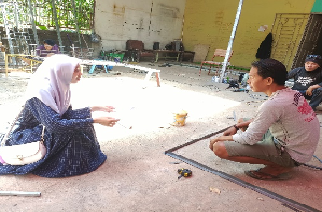Occupational eye health and productivity loss
The impact of photokeratitis among electric welders in Gowa, Indonesia
DOI:
https://doi.org/10.24252/sociality.v4i2.59465Keywords:
occupational health, photokeratitis, productivity, weldersAbstract
Occupational eye disorders, particularly photokeratitis, have received limited attention in developing regions, despite their significant impact on worker productivity. This study aimed to assess the relationship between photokeratitis symptoms and work productivity among electric welders in Gowa Regency, Indonesia. Employing an observational design with a cross-sectional approach, data were collected from 63 electric welders across 14 welding workshops in Samata Subdistrict, Somba Opu District. The presence of photokeratitis symptoms and productivity levels were assessed through structured interviews and categorized accordingly. Statistical analysis using the chi-square test (α=0.05) revealed that 75.0% of respondents with photokeratitis symptoms were less productive, while only 25.0% remained productive. Conversely, among those without symptoms, 87.0% were productive, and 13.0% were less productive. The association between photokeratitis and productivity was statistically significant (p=0.001; OR=20.000). These findings underscore the critical role of occupational eye health in sustaining productivity in rural industrial settings. Public health interventions, including the promotion of personal protective equipment and workplace safety education, are imperative to mitigate productivity loss among welders.
References
Adib Firmansah. (2015). Analisis faktor yang berhubungan dengan gejala fotokeratitis pada pekerja las listrik di Kecamatan Puger Kabupaten Jember [Undergraduate thesis, Universitas Jember].
Alatas. (2004). Efek radiasi pengion dan non-pengion pada manusia. Puslitbang Keselamatan Radiasi dan Biomedika Nuklir BATAN.
American Public Association. (2005). Preventing occupational disease and injury. Author.
Anies. (2007). Mengatasi gangguan kesehatan masyarakat akibat radiasi elektromagnetik dengan manajemen berbasis lingkungan. Badan Penerbit Universitas Diponegoro.
Cullen, A. P. (2002). Photokeratitis and other phototoxic effects on the cornea and conjunctiva. International Journal of Toxicology, 21(6), 455.
Davies, K. G., et al. (2007). Ocular effects of chronic exposure to welding light on Calabar welders. Journal, University of Uyo.
Direktorat Bina Kesehatan Kerja Kemenkes RI. (2013). Modul pelatihan penyakit akibat kerja.
Harris, P. M. (2011). Workplace injuries involving the eyes, 2008. United States: Bureau of Labor Statistics.
ICNIRP. (2007). Protecting workers from ultraviolet radiation. International Commission on Non-Ionizing Radiation Protection.
Kaharuddin, A. T. (2011). Anatomi dan fisiologi tubuh manusia. Alauddin University Press.
Keputusan Menteri Tenaga Kerja dan Transmigrasi No. 13 Tahun 2011.
Kurnianda, I. (2016). Faktor-faktor yang berhubungan dengan keluhan computer vision syndrome pada pekerja operator komputer di PT. Semen Tonasa Kabupaten Pangkep [Undergraduate thesis, UIN Alauddin Makassar].
Notoatmodjo, S. (2005). Ilmu perilaku kesehatan. Rineka Cipta.
Nurgazali. (2016). Gambaran faktor risiko sindrom photokeratitis pada pekerja las di PT. Industri Kapal Indonesia (Persero) Kota Makassar [Undergraduate thesis, UIN Alauddin Makassar].
Nur Najmi Laila. (2017). Keluhan subjektif photokeratitis pada mata pekerja las sektor informal di Kelurahan Cirendeu dan Ciputat Tangerang Selatan. Jurnal Penelitian, Program Studi Kesehatan Masyarakat, Fakultas Kedokteran dan Ilmu Kesehatan, UIN Syarif Hidayatullah.
Okuno, T., et al. (2001). Ultraviolet radiation emitted by CO2 arc welding. Annals of Occupational Hygiene, 45(7), 597. http://annhyg.oxfordjournals.org/content/45/7/597.full.pdf
Olishifski, J. B. (1985). Fundamentals of industrial hygiene. National Safety Council.
Pangaribuan, D. M. (2009). Analisis postur kerja dengan metode RULA pada pegawai bagian pelayanan perpustakaan USU Medan [Undergraduate thesis, Universitas Sumatera Utara].
Raihanil Jannah. (2016). Faktor yang berhubungan dengan keluhan photokeratitis pada pekerja di bengkel las listrik Kota Padang [Undergraduate thesis, Universitas Andalas].
Sri Wahyuni, A. (2012). Keluhan subjektif photokeratitis pada tukang las di Jalan Bogo, Bandung [Undergraduate thesis, Universitas Indonesia].
Susanto. (2014). Faktor yang berhubungan dengan keluhan photokeratokonjungtivitis pada operator las di Bengkel Las Kecamatan Biringkanaya Kota Makassar Tahun 2014 [Undergraduate thesis, Universitas Hasanuddin].
Tenkate, T. D., & Collins, M. J. (1997). Personal ultraviolet radiation exposure of workers in a welding environment. American Industrial Hygiene Association Journal, 58(1), 33–38.
Undang-Undang Republik Indonesia Nomor 36 Tahun 2009 tentang Kesehatan Nasional.
Wahyuni, T. (2013). Faktor risiko yang berhubungan dengan kejadian konjungtivitis fotoelektrik pada pekerja pengelasan di Kecamatan Cilacap Tengah Kabupaten Cilacap [Undergraduate thesis, Universitas Jenderal Soedirman].
Warouw, S. P. (1998). Tingkat radiasi sinar UV dan beberapa faktor yang berhubungan dengan keluhan mata welder’s flash pada pekerja las di industri kecil Pulo Gadung Jakarta Timur.
Yen, Y. L., et al. (2014). Photokeratoconjunctivitis caused by different light sources. American Journal of Emergency Medicine, 32(10), 1096–1100.

Downloads
Published
How to Cite
Issue
Section
License
Copyright (c) 2025 Ria Anggraeni Syahrir, Muhammad Israr

This work is licensed under a Creative Commons Attribution-NonCommercial-ShareAlike 4.0 International License.

